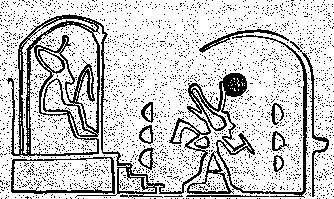|
"Instead of that old, dark, terrible drama of the king's
death, which had formerly been played to the hilt, the
audience now watched a solemn symbolic mime, the Sed
festival, in which the king renewed his pharaonic
warrant without submitting to the personal inconvenience
of a literal death. The rite was celebrated, some authorities believe, according to a cycle of thirty years, regardless of the dating of the reigns; others have it, however, that the only scheduling factor was the king's own desire and command. Either way, the real hero of the great occasion was no longer the timeless Pharaoh (capital P), who puts on pharaohs, like clothes, and puts them off, but the living garment of flesh and bone, this particular pharaoh So-and-so, who, instead of giving himself to the part, now had found a way to keep the part to himself. And this he did simply by stepping the mythological image down one degree. Instead of Pharaoh changing pharaohs, it was the pharaoh who changed costumes. The season of year for this royal ballet was the same as that proper to a coronation; the first five days of the first month of the 'Season of Coming Forth', when the hillocks and fields, following the inundation of the Nile, were again emerging from the waters. For the seasonal cycle, throughout the ancient world, was the foremost sign of rebirth following death, and in Egypt the chronometer of this cycle was the annual flooding of the Nile. Numerous festival edifices were constructed, incensed, and consecrated; a throne hall wherein the king should sit while approached in obeisance by the gods and their priesthoods (who in a crueler time would have been the registrars of his death); a large court for the presentation of mimes, processions, and other such visual events; and finally a palace-chapel into which the god-king would retire for his changes of costume. Five days of illumination, called the 'Lighting of the Flame' (which in the earlier reading of this miracle play would have followed the quenching of the fires on the dark night of the moon when the king was ritually slain), preceded the five days of the festival itself; and then the solemn occasion (ad majorem dei gloriam) commenced. The opening rites were under the patronage of Hathor. The king, wearing the belt with her four faces and the tail of her mighty bull, moved in numerious processions, preceded by his four standards, from one temple to the next, presenting favors (not offerings) to the gods. Whereafter the priesthoods arrived in homage before his throne, bearing the symbols of their gods. More processions followed, during which, the king moved about - as Professor Frankfort states in his account - 'like the shuttle in a great loom' to re-create the fabric of his domain, into which the cosmic powers represented by the gods, no less than the people of the land, were to be woven."
"The king, wearing now a short, stiff archaic mantle, walks in a grave and stately manner to the sanctuary of the wolf-god Upwaut, the 'Opener of the Way', where he anoints the sacred standard and, preceded by this, marches to the palace chapel, into which he disappears. A period of time elapses during which the pharaoh is no longer manifest. When he reappears he is clothed as in the Narmer palette, wearing the kilt with Hathor belt and bull's tail attached. In his right hand he holds the flail scepter and in his left, instead of the usual crook of the Good Shepherd, an object resembling a small scroll, called the Will, the House Document, or Secret of the Two Partners, which he exhibits in triumph, proclaiming to all in attendance that it was given him by his dead father Osiris, in the presence of the earth-god Geb. 'I have run', he cries, 'holding the Secret of the Two Partners, the Will that my father has given me before Geb. I have passed through the land and touched the four sides of it. I traverse as I desire'." (Campbell 2) |
